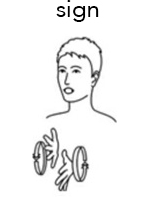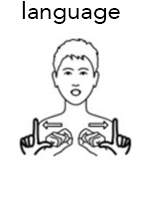This is an old revision of the document!
Table of Contents
Dutch Sign Language in the Netherlands
Language designations:
Language vitality according to:
Linguistic aspects:
- No script.
Language standardization
Since there is no script, there is no standardized orthography. However, there is a standardized lexicon consisting of images provided by the Dutch Sign Center (Gebarencentrum) 2).
Demographics
Language Area
Dutch Sign Language is spoken in the Netherlands, Aruba, Curacao, and Suriname. There are seven dialects in the Netherlands, five of which developed around the original deaf schools in Groningen, Amsterdam, The Hague, Rotterdam and 's-Hertogenbosch 3).
Speaker numbers
13,000 worldwide: 7,500 as first language, 5,500 as second language 4). See Ethnologue for more information.
Education of the language
History of language education:
Already in the 18th century, deaf schools were founded in the Netherlands, which provided the opportunity to communicate using sign language. Henri Daniel Guyot founded the first deaf school in the Netherlands in 1790 5): the Guyot Institute in Groningen. Other deaf schools followed in 's-Hertogenbosch (1840), Rotterdam (1853), The Hague (1888), and Amsterdam (1911). Until 1915 sign language was used in education. From 1915 to 1980, the use of Dutch Sign Language was forbidden in all deaf schools 6)7). This oral period was the result of the Resolution of Milan in 1880, where hearing teachers decided it would be better for deaf children to be educated solely in a spoken language. This period ended when the results of deaf education proved to be very disappointing and it was shown that sign languages are true languages 8). The oral period was followed by the Total Communication period, when hearing teachers were learning signs and used Signed Dutch (Nederlands met Gebaren), but not Dutch Sign Language. This was not only due to the lack of materials: most professionals did not consider NGT a true language9). In 1995, this method was replaced by a bilingual approach, because research prompted to favour NGT over NmG. The practice of this bilingual policy varies a lot (see Education in practice).
Legislation of language education
The European Union has recognized sign languages as languages in 1988 and advised the member states to officially recognize sign languages 10). Since 2003 sign languages are recognized as minority languages in the European Union.
Dutch Sign Language is not recognized by the government of the Netherlands11) 12). In 1997, the government stated that a standardized lexicon was a condition to recognize NGT. This basic lexicon was developed13), but legal recognition has not happened. A private member's bill to recognize NGT legally is currently in progress 14).
Despite the lack of official legal recognition, there are a few implicit legal recognitions15)16). For example, there is a right to education in NGT and to have sign interpreters, and organizations that do research on NGT receive subsidy. The establishment of bachelor's-degree programs in NGT teacher and interpreter training17) can also be seen as a form of recognition.
Bodies controlling enforcement of educational laws:
The Dutch Deaf Council (Dovenschap) has been working with researchers, organizations in deaf education and the organization of parents of deaf children (FODOK) for 30 years to improve deaf people's accessibility to the hearing society, change the status of NGT and implement a sign-language policy.
The Dutch Sign Center can be viewed as a national institution supporting and promoting the teaching and learning of NGT. This is an independent national center funded by the Department of Education for NGT lexicography.
The universities of Utrecht, Nijmegen, and Amsterdam also play an important role in the language planning of Dutch Sign Langauge.
Education in practice
Schools for deaf pupils:
- The Institute for the Deaf in 's-Hertogenbosch, the deaf school with the history of the strictest oral policy, started implementing NGT in education in 1997. It currently provides primary and secondary education,
- The Rudolf Mees Institute in Rotterdam started bilingual projects and teamteaching in 1991. The first grades are bilingual, while the higher grades focus more on NGT,
- The J.C. Ammanschool in Amsterdam provides primary and secondary education. It applies teamteaching and teaches subjects in both Dutch and NGT. They focus on the content and communication instead of the specific language and have developed their own colour system for writing in Dutch.
- The Guyot Institute for the Deaf in Groningen provides primary and secondary education for deaf and hearing impaired children. It was the first to adopt a bilingual policy and hired more deaf signers as teachers and other personnel. From the beginning of the curriculum, mostly NGT is used and teamteaching is applied here as well. The school also offers accomodation for pupils who live too far away to commute evry day. Due to educational reform which aims to place all students in regular schools, the Dutch State has decided to close this accomodation as soon as it is no longer needed 18)
Outcomes of education:
So far, there has been no research on the question whether bilingual education for deaf students gives better learning outcomes than other forms of education. It is known that the proficiency in NGT of deaf children with hearing parents lags behind on that of deaf children with deaf parents, but it is unclear why this is the case21).
Difficulties in education:
Difficulties in the education of NGT are the lack of teaching and testing materials in the language and the small amount of deaf teachers. Also, teachers' level of NGT proficiency is insufficient in many schools22). Another challenge is the increase in number of very young children with a cochlear implant23), since their parents are often advised to use Signed Dutch with their child instead of Dutch Sign Language. As a result, these parents demand hearing teachers who use Signed Dutch or send their child to regular instead of special education.
Preservation of the language:
Although the use of NGT was forbidden in deaf schools in the oral period, people still used it outside of school. This way, the language was not lost, but it did cause regional and even generational differences. More importantly, the status of NGT was greatly affected by the oral period: in that period it was seen as a language inferior to spoken Dutch 24). The return of Dutch Sign Language in education has certainly added to the prestige of the language, showing people that NGT is a true language. Generally, users of NGT no longer feel ashamed to use their mother tongue.
Learning resources and educational institutions
- The Dutch Sign Center coordinates all efforts with respect to the development of NGT modules and develops additional materials
- Standard lexicon NGT
- Kentalis offers various courses
- Nederlandse Gebarentaal level B1 (purchased from the 'Instituut voor Gebaren, Taal en Dovenstudies' at the Hogeschool Utrecht)
- And includes twenty schools for special primary and secondary education
- The Auris Group includes eigtheen schools for special primary and secondary education
- Sign Language for everyone aims to bridge the gap between hearing people and people who are deaf or hard of hearing
- TPR storytelling course 'Het hele verhaal in Gebarentaal'
- Online course to learn Dutch Sign Language
- The University of Amsterdam offers the opportunity to learn Dutch Sign Language in the programme of linguistics
- The Hogeschool Utrecht offers the bachelor programme teacher/interpreter NGT
- The group Sprong Vooruit has developed the teaching materials 'Ik & Ko' and 'Taal op Maat' for primary education





